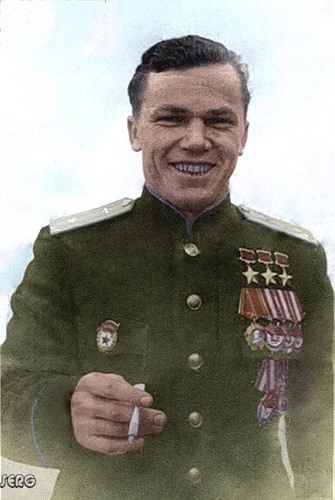Really,Major Erich Hartmann claimed, and was credited with, shooting down 352 Allied aircraft, including 348 Soviet and four American. His colleagues in Luftwaffe 52th Fighter Squadron, Gerhard Barkhorn and Gunther Rall , claimed about 301 and 275 victories. These figures contrast sharply with the results of the best Soviet fighter pilots: I. Kozhedub had 62 victories , A. Pokryshkin had 59 and N. Gulayev had 57. But few people realized that there is no validity of comparing the results of combat activities of pilots who fought in different conditions and with different intensity of combat operation. No one tried to assess the value of such a factor as “the biggest number of victories” from the point of view of the system of the Air Force of the whole country. What do these numbers tell us: what is “hundreds of downed” : “girth of a bicep”, or “body temperature of a patient with fever”?
The answer to this question is not as obvious as it may seem at first. As a rule, the party who loses the air war has the highest number of individual pilot’s scores. Pay attention to this: not one, two or three fights but the air war as a string of battles. This phenomenon manifested itself already in the First World War. For example, the German pilot Manfred von Rihtgoffen shot down 80 Allied aircraft; it was the highest result among fighter pilots 1914-1918. During the second World War it happen again, not only on the Soviet-German front. At the Pacific Ocean there were also people like Hartmann. Tatsugo Iwamoto ,a Japanese lieutenant of naval aviation, knocked seven fighters «F4F» «Wildcat", four “P-38” “Lightning”, forty eight «F4U» «Le Corsaire", two “P-39” “Cobra”, one "P-40 ", twenty nine« F6F »« Hellcat “, one” P-47 “” Thunderbolt ", four " Spitfire ", forty eight bombers« SBD »« Dauntless “, eight bombers” B-25 ". Just over Rabaul the ace won 142 victories in air combat; and totally he has 202 (!) Downed aircraft. Another Japanese fighter pilot, Lieutenant Hiroyoshi Nishizawa, shot down 103 (according to other sources - 86) American aircraft. The american pilot with the highest scores in the same battle ground, Richard Ira Bong, shot down 2.5 times less. On Bong’s account there are even fewer downed aircraft than I. Kozheduba had: there are 40. We can see an absolutely identical picture if we look at the “low-intensity conflict”: Soviet-Japanese border incident in Khalkhin Gol. A Japanese pilot, Hiromichi Shinohara, claimed that he downed 58 Soviet aircraft from May 1939 until his death on August 28 in the same year. The best Soviet pilot inKhalkhin Gol, Sergei Gritsevets, had in his account 12 Japanese planes.
The reason why Luftwaffe aces scored so high lies in the extensive use of the German Air Force (6 missions a day by a single pilot in major operations) and a larger number of targets due to the quantitative superiority of the Allies ( the probability of encountering an enemy aircraft in the sky was higher). The top German ace Erich Hartmann had 1425 missions, Gerhard Barkhorna had 1104 missions, Walter Krupinski (197 victories) had 1100 missions. I.N. Kozhedub had only 330 missions. If you divide the number of missions by the number of downed, then the German top aces and best Soviet fighter pilot had roughly 4-5 missions per victory. It is not difficult to guess that, if Kozhedub had 1425 missions, he could have easily downed three hundred planes. But there was no practical sense in that. If you want to perform 60 missions a day to covering your bombers and ground troops or to intercept enemy bombers, then you can make it with ten aircraft and exhausted pilots having six flights a day; the other option is to make it with sixty aircraft and pilots having one flights a day. Soviet Air Force chose the second option, the command of the Luftwaffe - the first.
High intensity of Luftwaffe aircraft use was the result of the Third Reich commandment strategy ; they tried to cover a huge front with the means clearly insufficient for this task. German pilots fought almost without stop. They had to serve different parts of the front, depending on defensive or offensive operations.
The Luftwaffe strategy allowed the aces to increase scores, but in the long run it was a defeat strategy. One of the participants of the battle on Khalkhyn Gol, a Japanese fighter pilot Ivory Sakai, recalled: "I have done 4-6 missions a day and in the evening I was so tired that I almost did not see anything. Enemy planes flew at us like a huge black cloud, and our losses were very heavy. "The same could be said about the Luftwaffe pilots fought on the Western and the Eastern Front during the World War II.
Now compare fighting efficiency of pilots :

Erich Hartmann,352 victories in 825 battles, efficiency ratio 0,394

Ivan Kozhedub,62 victories in 120 battles,efficiency ratio 0,516

Alexandr Pokryshkin, 59 victories in 165 battles ,efficiency ratio 0,378

Nikolay Gulayev,57 victories in 69 battles,efficiency ratio 0,826








 ).
).